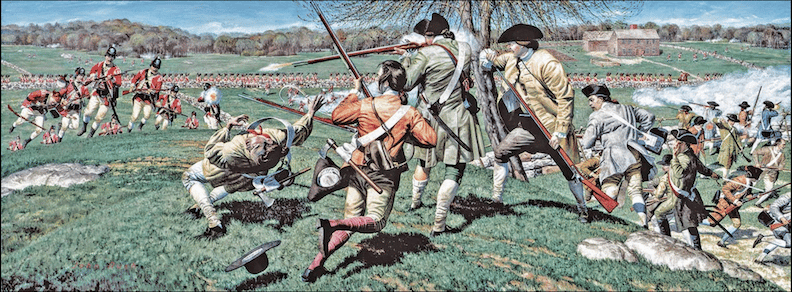
“Battle of Lexington and Concord ” painting by John Rush in the Minuteman National Historic Park, Concord MA.
Last week, two old friends stopped by for a visit.
French President Emmanuel Macron dropped into Washington, where he was greeted by a fife and drum corps garbed in colonial uniforms with tri-cornered hats.
Some 430 miles to the north, the Prince and Princess of Wales (aka William and Kate) were in Boston discussing climate change with the descendants of colonialists who fought the American Revolution. It was only the third time that British royalty has visited the city.
Unmentioned amid the pomp of the two diplomatic visits was the name Paul Revere. His midnight ride in 1775 initiated the armed struggle against the British and inspired a second revolution 14 years later in France. Yet Revere is not regarded as one of America’s founding fathers. His image has never appeared on U.S. currency and his story seldom is mentioned in European texts.
So, who was Paul Revere?
Listen, my children, and you shall hear
Of the midnight ride of Paul Revere.
On the eighteenth of April, in Seventy-Five;
Hardly a man is now alive
Who remembers that famous day and year.
When poet Henry Wadsworth Longfellow wrote those lines in 1862, he was correct — hardly anyone had heard of Paul Revere. The early histories of the American Revolution didn’t mention him.
And Wadsworth’s still right; not many people today remember much about 1775.
So let’s go back to 1775 in Boston and meet a fairly obscure silversmith named Paul Revere. Today, Paul Revere is an institution, at least in Boston. You can tour his house, see his portrait, buy reproductions of his silver work, walk the streets he walked, have a drink in his favorite tavern and even leave pennies on his grave. In a city that spawned a revolution, there is no greater figure than Paul Revere — a fact that would have surprised every Boston resident in 1775, the modest Paul Revere most of all.
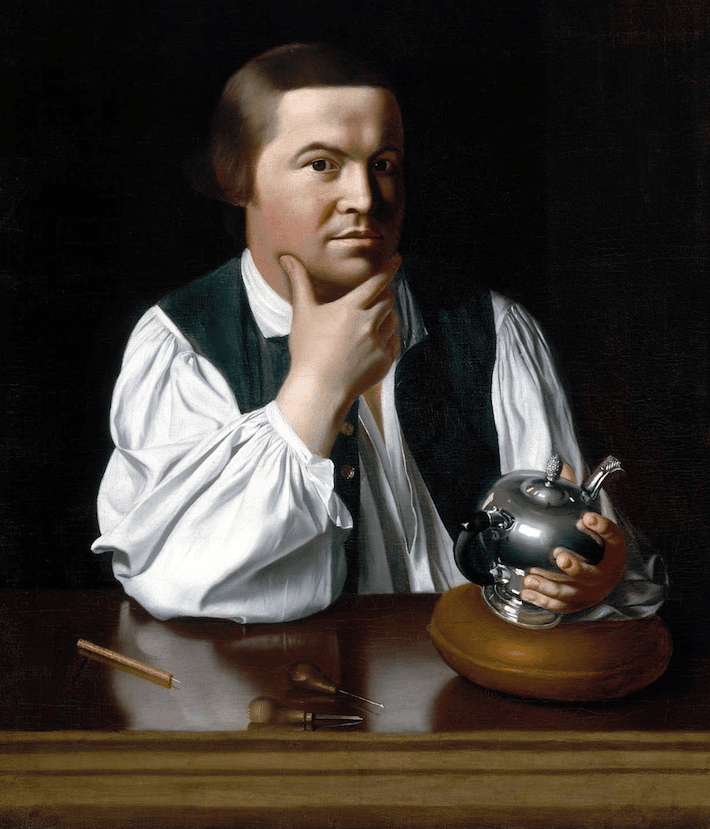
“Paul Revere” painting by John Singleton Copley, Museum of Fine Arts, Boston, MA
Because in 1775 he was just another rebel, a member of a group called the “Sons of Liberty.” He led a contingent of 30 “mechanics,” as artisans called themselves, whose purpose was to watch the redcoats. Whenever the British army tried a foray into the countryside, Revere and his men acted as express riders to spread the alarm.
A Society Divided
The year 1775 had many disturbing similarities to today. Boston, then the nation’s third-largest city, was divided by political differences that often spilled over into physical violence, destruction of property, and general unlawfulness. Rebels, incensed by the principle of being taxed without having representation in Britain’s Parliament, had dumped a fortune of tea into the ocean rather than pay a small tax on it (a tax that was far less than what British citizens paid in England). British tax collectors were seized by mobs of rebels and tarred and feathered.
Rebel citizens were still outraged over the verdict of the so-called “Boston Massacre.” Some years earlier, a British redcoat platoon of soldiers, pelted by snowballs and rocks, had turned, and fired into the mob, killing five people. John Adams (America’s future second president) defended the soldiers and got them off, but there was still resentment over the heavy brutality used by the troops.
The political divide was so strong that families had to choose a side – rebel or loyalist — with the result that relatives stopped talking to each other, including Ben Franklin who stopped communicating with his son. Newspapers were all one-sided, giving only their political half of the story.
By 1775, the British, fed up with the rebels, retaliated by closing the port of Boston and imposing military rule. Throughout the city, among rebels and redcoats alike, there was a fear that the powder keg that Boston had become was going to explode.
And then it happened.
A Fatal Misunderstanding
The British colonial governor in Boston, Thomas Gage, often sent British troops out into the countryside to demonstrate British control over the colony. The troops, however, were under strict orders not to fire or escalate a situation if they encountered rebels.
To the Sons of Liberty, these British marches had the reverse effect. They came to feel that if they just showed strength and stood their ground, the British redcoats would always back down.
Both views were soon to be tested in the pale light of early morning on a pretty village green in Lexington.
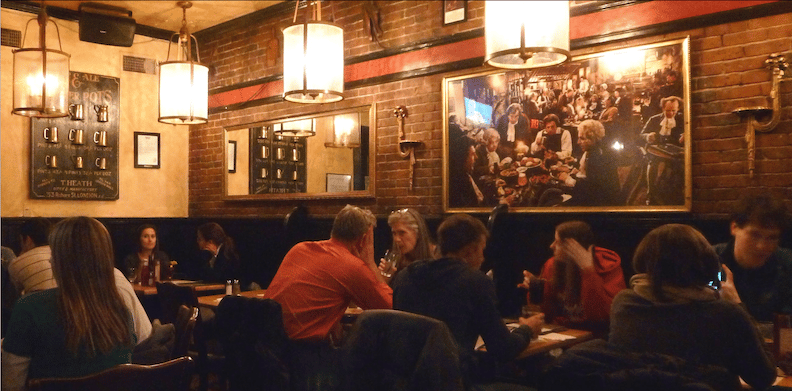
Interior of Boston’s Green Dragon Tavern with a painting depicting customers from the Revolutionary War period. Photo by Rich Grant
Like many a good tale, this story begins in a tavern. On the afternoon of April 18, a 13-year-old boy named Sam Ballard was in Boston’s Green Dragon Tavern where he overheard two British officers talking about a raid to Lexington and Concord to arrest revolutionary leaders Sam Adams and John Hancock. Ballard told the landlord at the Green Dragon, who sent a messenger to Paul Revere’s house.
The original Green Dragon was torn down in 1854, but a reconstruction was built nearby at 11 Marshall Street. Although not an exact reproduction, it’s a great Irish bar with a colonial feel of wood floors, muskets on the walls, old lanterns and a large painting that helps you imagine the Green Dragon as it must have appeared in 1775, filled with rebels engaged in deep discussion while smoking clay pipes and downing tankards of ale.
After a pint in the tavern, it’s a pleasant ten-minute walk through Boston’s historic streets to Paul Revere’s house. Built between 1650 and 1680, the Revere House is the oldest dwelling in Boston. It is the only colonial building of this type to survive in the heart of an American city. Paul Revere lived here for 30 years (1770-1800). The gray dwelling with its second story overhang was restored in 1907 to reflect both its original 17th century appearance and modifications made during Revere’s residence.
It is now a museum where on self-guided tours, it is possible to rub shoulders with hundreds of international visitors as you squeeze up narrow stairways to view rooms and exhibits that continue the story.
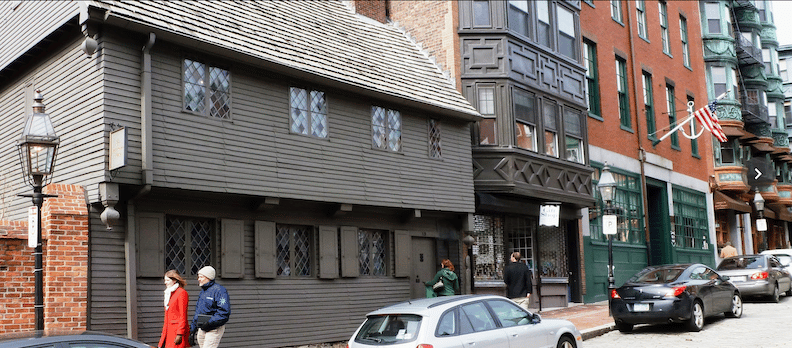
Paul Revere’s house, the oldest home in Boston, is also a museum. Photo by Rich Grant
Boston’s Nest of Spies
Boston in 1775 was a city filled with spies, and bits of information had been coming to Revere’s house all day. No one was sure exactly what the British were up to, but something was afoot, so Paul Revere was ordered to set off on a 20-mile ride to Lexington to spread the alarm.
His first stop, which you can follow, was right around the corner to the Old North Church. Built in 1723, it is Boston’s oldest standing church. Though the steeple was rebuilt a number of times, it is today as tall and white against a blue sky as it would have been 300 years ago. A small museum in the church continues the tale.
In 1775, before massive landfill projects, Boston was located on a neck of land surrounded by water. If the British sealed off the neck, an express rider would be trapped within the city. The solution was to send a message out of Boston across the river by light. Revere planned for the church sexton, Robert Newman, to watch the British troops depart and then hang lanterns in the Old North, which offered the highest steeple in the city. The code was one lantern if the British were leaving for Lexington by land over the neck, two if by sea ferried over the river.
About 10 p.m., with two lanterns dimly glowing across the water and the moon rising, Revere had himself rowed with muffled oars across the Charles River, directly under the guns of an English ship. On the other side, associates tipped off by the lanterns provided him with a horse named Brown Beauty, and he set off for Lexington.
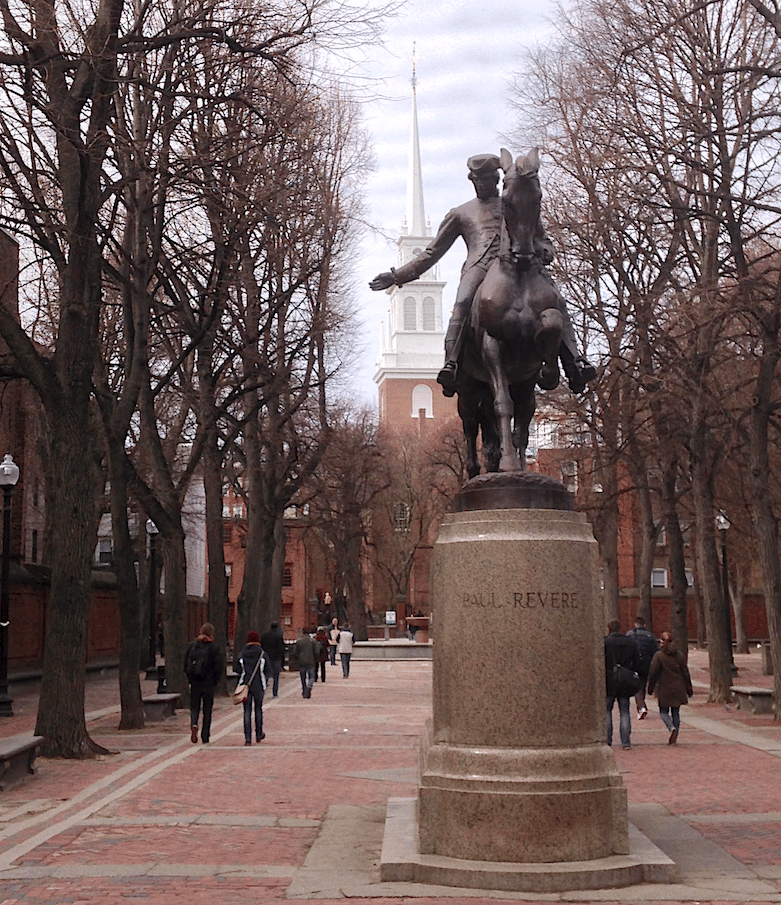
Statue of Paul Revere with Old North Church in the background. The church steeple remains one of the highest structures in North Boston. Photo by Rich Grant
A hurry of hoofs in a village street,
A shape in the moonlight, a bulk in the dark,
And beneath, from the pebbles, in passing, a spark
Struck out by a steed flying fearless and fleet;
That was all! And yet, through the gloom and the light,
The fate of a nation was riding that night.
Suburban Boston was once farm country with stone walls and twisting dirt lanes. There is no point retracing the exact route of Paul Revere; it’s easier to follow the Concord Turnpike and head directly to Lexington. It was here, at the Hancock-Clarke House, that Paul Revere finally arrived at midnight, his horse’s flanks coated with sweat and blood. A sergeant guarding the house told him to stop making noise, there were people sleeping.
“Noise!” Revere shouted. “You’ll have noise enough before long. The Regulars are coming out!”
Minute Men at the Ready
This was as close as he ever came to the famous, “The British are coming!” That would have been an insane thing to say. In 1775, everyone in Massachusetts was British. Rather than shouting that out as he rode to Lexington, an elaborate alarm system was in place. Revere knew the houses of militia captains and was able to inform them, and they in turn informed their “Minute Men” (militia trained to be ready to turn out in a minute’s notice) by ringing church bells and firing warning cannons.
Lexington is still a pretty little village and the yellow house where Hancock and Adams were staying has been preserved with furnishings and portraits owned by the Hancock family. Of particular interest are exhibits from the coming battle, which include William Diamond’s drum — the very instrument the young man beat to call the militia to the town green, which is our next stop, just a five-minute walk away.
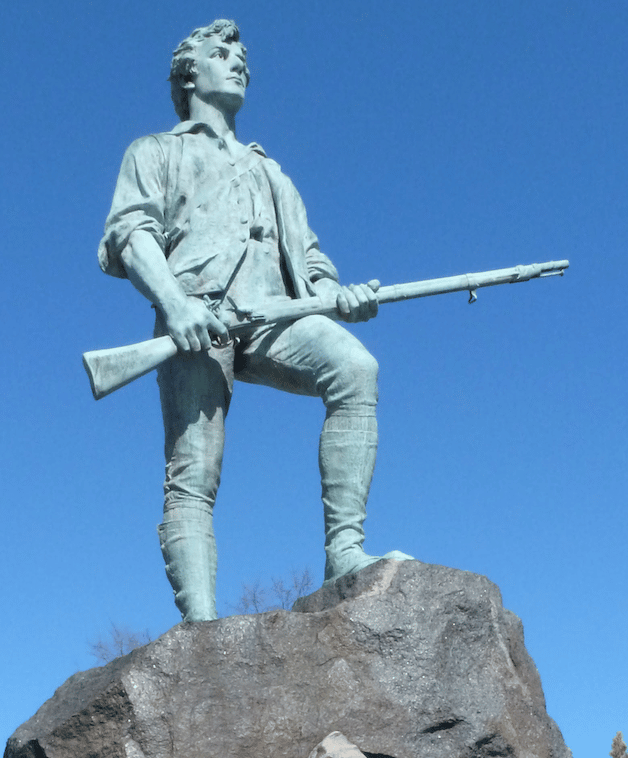
There was no U.S. army at the start of the revolutionary war in 1775. The Minute Men, like the one depicted here in Lexington, were farmers and shopkeepers. Photo by Rich Grant
The traditional New England town center is a lovely grass park surrounded by white houses and churches. On the edge of the green is the Buckman Tavern. It was here that Revere later wrote, he “refreshid” himself after the long ride (no doubt with a tankard of ale) before setting off yet again, this time to spread the alarm to Concord. The Buckman Tavern is also where the militia, awakened by ringing church bells, began gathering to wait for the possible arrival of the British soldiers.
You can stand in this same room today, and look out the window toward the green, trying to imagine what it would be like in the pale light of an April morning for a group of minute men to see 700 of the world’s finest troops in their bright red coats as they marched into town.
British General Gage had planned a special forces operation unlike any before. In 18th century linear warfare, the flanks of an army were the most vulnerable so every regiment had two special companies for the right and left flanks: light infantry, which consisted of the most athletic men, trained to act independently, and grenadiers, who were all over six feet tall and wore bear skin hats to make them seem even more formidable.
Gage assembled these flank companies from every regiment and combined them with Royal Marines to make a strike force of unusual power. The troops were to carry only one day’s rations and were to make a forced march to Lexington, capture the rebel leaders if possible, and then proceed to Concord to destroy a cache of weapons and gunpowder stored there by rebels.
As the minutemen gathered in the tavern, Revere raced for Concord, but his luck finally ran out when on the pitch-black road he galloped into an advance party of British cavalry. An English officer clapped a pistol to his head and threatened to “blow his brains out.” There is a historic marker that indicates the site of his capture.
But for the British it was too late. Revere had warned Lexington and his companion riders William Dawes and Dr. Samuel Prescott (left out of the poem, no doubt, because their names are harder to rhyme) got through to Concord.
Back in Buckman’s Tavern, the rebel militia commander, Captain John Parker, began to doubt the British were coming. He sent lookouts down the road and relaxed the men. And then everything happened quickly. The lookouts came running with news that “a thousand redcoats” were just minutes from town. Parker assembled 77 armed minutemen on the green in two rows. It’s hard to know what he was thinking. They were outnumbered ten to one. Parker must have believed that the British, as they had in the past, would just march by.
But the soldiers were in a frenzy. Hearing church bells ringing and cannons fired, they knew their secret operation was discovered. There was no possibility of a standoff. With shrill fifes piercing the morning air and drums beating, the angry column of redcoats marched on to the green in anger and fanned out into a line 30 yards wide. Realizing his situation was untenable, militia leader John Parker finally told his men to scatter. Unfortunately, his order coincided with that of a British officer who yelled, “Lay down your arms, you damn rebels!”
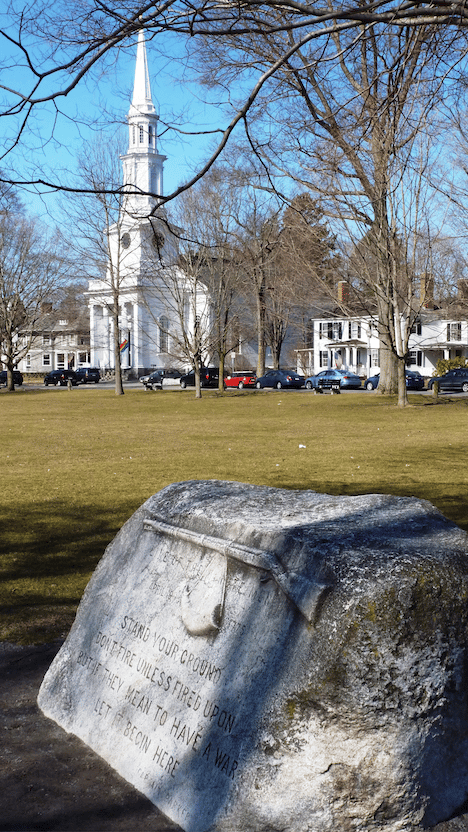
The first shots that began the American Revolution in 1775 were fired on the village green in Lexington. Photo by Rich Grant
And Then a Shot Rang Out
No one knows who fired it. It was a “shot heard round the world.” The redcoats went wild and fired a volley into the standing militia. They reloaded and fired again, and then broke and chased the rebels with fixed bayonets. British officers on horses rode into the chaos, slashing with their swords at their own men trying to bring them back to order, but it was hopeless as the slaughter continued.
A typical musket in 1775 fired a lead ball three-quarters of an inch in diameter. At point blank range it did frightful damage, no matter what part of a human body it hit. Eight militia were down dead, ten wounded. Rebel Jonathan Harrington managed to crawl off the green, only to die in a pool of blood in front of his family at his own front door.
British drummers finally sounded “cease-fire” and troops returned to order, but it was too late. Many of the British officers realized it would be suicide to continue to Concord. But orders were orders. The redcoat column reformed and with drums beating, marched once again down the road.
Rather than follow them, it’s best to drive now to Concord and Minute Man National Historic Park. The visitor center has films and exhibits on the battle, but best is to take the short walk out to North Bridge, an elegant curving arched wood bridge that looks so tranquil and peaceful it is hard to picture it as a battlefield.
But a battle it was. When the British arrived in Concord, they began a house-to-house search for weapons and sent three companies out to guard this bridge and protect their northern flank from the forming rebel militia who were outraged and swirling in all directions. Back in Concord, the redcoats were burning captured military supplies when a house accidentally caught fire. Ironically, redcoat soldiers joined the bucket brigade to put the fire out, but rebel militia at the North Bridge could only see the smoke and thought the soldiers were burning the entire town. Some 500 rebels advanced on the bridge. Falling back, the outnumbered redcoats formed in two lines on the bridge, and again, someone fired. Followed by a full volley from the British. Two patriots fell and a militia leader yelled, “Fire! For God’s sake fire!” Five hundred muskets exploded, and two British soldiers fell dead, with eight or ten wounded. It was the first time Americans had fired at British troops.
You know the rest. In the books you have read,
How the British Regulars fired and fled, —
How the farmers gave them ball for ball,
From behind each fence and farm-yard wall.
What happened in the next few hours changed the world. The British began their long retreat to Boston, with minutemen sniping at them from behind every barn, tree and stonewall. You can follow and walk along with the retreat for five miles on the national park’s Battle Road. It is one of the great battlefield walks of the world, virtually unchanged. The road of the battle is clay and gravel and winds through the same countryside of fields and woods, passing by historic homes and a tavern that look exactly as they would have appeared.
Bullets and Bayonets
Muskets back then were barely accurate to 100 yards, so British light infantry were sent out as flankers to protect the retreating column and keep the rebel Minutemen farther away. But by this time in the battle, as many as 3,500 militia were swarming the countryside, steadying their muskets on stone walls and blazing away at the massed red column as it snaked along the road.
Thirsty and tired (the redcoats would march 40 miles this day), the British column entered a nightmarish hell. Bullets zipped around them, occasionally striking bone, and flesh with terrible effect. Soldiers would try to help a wounded comrade down the road, but this only slowed progress and made both ripe targets for another hit. The Minutemen would fire, then run away to get ahead of the column and fire at them again.
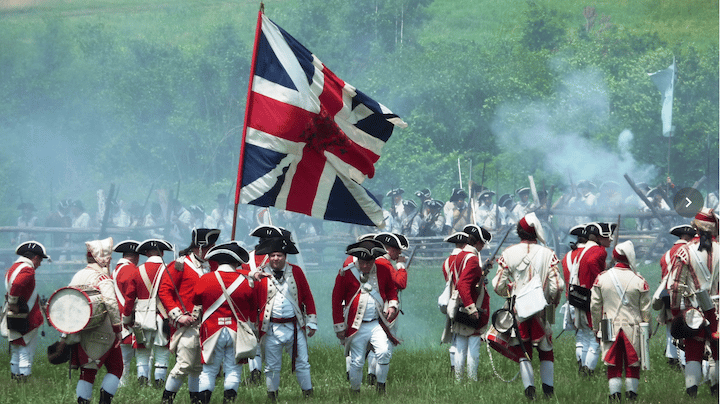
Historical reenactments capture the carnage the British endured during their return to Boston from Lexington and Concord. Photo by Rich Grant
Redcoat flankers, meanwhile, would sneak behind the Minutemen and bayonet them without quarter. Some 11 rebels were killed by a surprise attack in one house by a British flanking party. An 80-year-old rebel, Samuel Whittemore, ran into five British light infantry. He killed one with his musket, and shot another with a pistol before being himself shot through his cheek and repeatedly stabbed by bayonets. He survived and lived to be 98.
By nightfall, 273 of the King’s troops were killed, wounded, or missing, along with 95 casualties among the colonialists. It is impossible to overestimate the impact the high casualties of this battle had on both sides. In today’s U.S. population, it would be the equivalent of 30,000 troops killed or wounded in a single day – a level of violence as shocking as Pearl Harbor or 9-11.
There was no going back. The American Revolution had begun. And it had begun to a considerable extent because of Paul Revere. His network of express riders was able to spread the message so well, that by the end of the day almost 4,000 militia had mobilized and fought in the battle, coming from as far as 20 miles away.
Strangely enough, Paul Revere’s role was forgotten for almost a century. In 1862, during the bleak days of the Civil War, Longfellow was looking for a subject that would give the Union hope. He found his inspiration in the forgotten tale of a silversmith express rider.
Although the poem is a thrilling account of the ride, it is the closing that best captures why Paul Revere’s popularity has endured into the 21st century.
For, borne on the night wind of the Past,
Through all our history, to the last,
In the hour of darkness and peril and need,
The people will waken and listen to hear
The hurrying hoof beats of that steed,
And the midnight message of Paul Revere.
As we near the 250th anniversary of the famous ride, America is more divided than ever. Will a new “Paul Revere” emerge “in the hour of darkness and peril.” A leader with a call, not to war and violence, but to peace and reconciliation. A message that reminds us all that, unlike in 1775, we are now one nation with common interests, hopes and dreams.
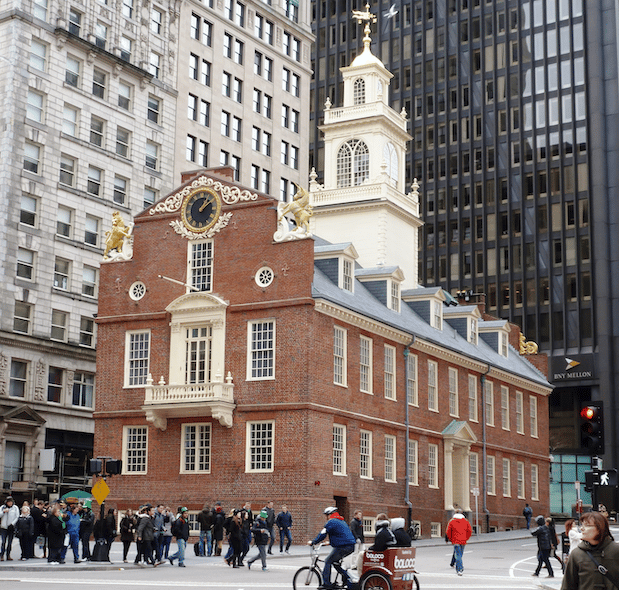
Faneuil Hall on the 2.5-mile-long Freedom Trail that winds around Boston. Photo by Rich Grant
IF YOU GO….
Best Book To Read First: Paul Revere’s Ride by David Hackett Fischer, Oxford University Press 1994, is the best account of the ride and the fighting at Lexington and Concord. It reads like a novel with spies, daring escapes and bloody battles.
Freedom Trail This 2.5-mile-long walk (marked by red bricks or a painted red stripe) is easy to follow as you move from the site of the Boston Common to the Boston Massacre and on to Bunker Hill. An interesting stop is Granary Burying Ground, where Paul Revere, John Hancock and Sam Adams are laid to rest, and the Old State House, built in 1713. Faneuil Hall and Quincy Market are two of the city’s biggest tourist stops and are along the trail and worth a look. Don’t assume everything interesting is on the trail – there are many great things to see a block or two off.
Green Dragon Tavern, 11 Marshall Street. The historic looking tavern today attracts a young crowd and has live music, but it is still worth a look and a beer. Better for meals is to head next door to the Union Oyster House. Opened in 1826, it claims to be America’s oldest restaurant and it’s certainly one of Boston’s most famous seafood houses. It’s a huge, rambling place with lots of different rooms, creaking wood floorboards and plenty of atmosphere. Sit at the unique circular raw bar on the main floor and watch them shuck your oysters and clams or ask to be seated in the Kennedy room (this was John F. Kennedy’s favorite Boston restaurant and there is a plaque at the booth where he often ate). If you want to go to a bar where Paul Revere drank, you must go to the Warren Tavern in Charleston. John, Paul, and George (Hancock, Revere and Washington) all drank here. It’s at the base of Bunker Hill and was the first building rebuilt after the British burned the town during the famous battle. Worth a stop, but the interior is more local pub than historic site.
The Paul Revere House, 19 North Square, It doesn’t look like much from the outside, but go through the gate there’s an interesting courtyard and the interior rooms are well worth the entrance fee. Some of the rooms have the original floorboards.
Old North Church, 193 Salem Street, is open every day from 9 a.m. to 6 p.m. It’s beautiful inside and out. The Paul Revere statue is in a park behind the church. As you walk around Boston and Charleston, always keep an eye out for the church tower. It was the highest building in Boston in 1775 (which is why it was perfect for the signal lamps) and is still one of the most prominent buildings in the North End Italian district. The neighborhood is even better. There are five Italian bakeries within a musket shot, and dozens of Italian restaurants nearby.
Hancock-Clarke House, Lexington contains furnishings and portraits owned by the Hancock and Clarke families and exhibits from the battle of Lexington. 36 Hancock Street, Lexington.
Buckman Tavern, across from Battle Green in Lexington, appears very much today as it did on the fateful morning in 1775.
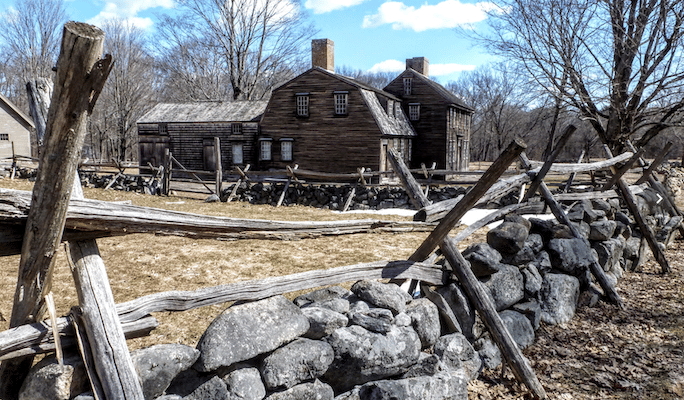
The Hartwell Tavern on Battle Road looks much like it would have the day of the fight in 1775. Photo by Rich Grant
Minute Man National History Park, preserves 900 acres of land of the battlefields of Lexington and Concord. They have done a spectacular job of preserving parts of the road along which the battle took place, and today you can hike or bike five miles of the Battle Road Trail. It’s particularly nice from the Paul Revere Capture Site to the Minute Man Visitor Center, or from Hartwell Tavern to the Bloody Angle, scene of the most severe fighting. The Hartwell Tavern is the most picturesque stop of the trip. Walking along the trail here is like strolling into an 18th Century painting. The North Bridge in Concord is another very pretty area with a nice trail.
Longfellow National Historic Site, preserves the home in which poet Henry Wadsworth Longfellow lived from 1837 to 1882, including the time when he wrote his famous poem about Paul Revere. George Washington headquartered here for 16 months from 1775 to 1776. Located in Cambridge at 105 Brattle St.
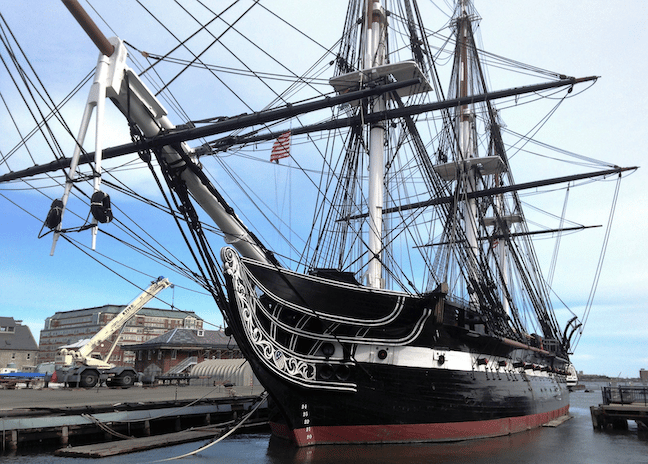
Docked in Charleston where Paul Revere began his midnight ride, the USS Constitution is still a recognized warship in the U.S. Navy. Photo by Rich Grant
USS Constitution. Built in 1797, this is the oldest warship still floating in the world. Paul Revere did the copper sheathing for the 54-gun frigate. A craftsman, Revere dabbled in metal trades including engraving and early dentistry. Free tours let you stroll the two-gun decks. Next door is the Constitution Museum which has interactive displays on the great battles of “Old Ironsides,” as well as fun exhibits on how to sail a three-masted frigate. You can arrive here from downtown Boston by ferry, following the same route across the water that Paul Revere took before his ride. Walk along the waterfront in Charleston and you can stumble on a marker that indicates the approximate site where Revere landed and met his horse, Brown Beauty.![]()
Rich Grant is a Denver, Colorado writer specializing in American history. His past stories for EWNS included a look at the life of Edgar Allan Poe and George Washington’s Philadelphia.

